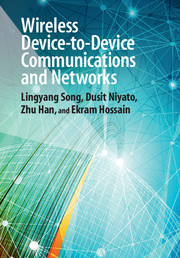Book contents
- Frontmatter
- Dedication
- Contents
- Preface
- Part I Introduction
- Part II Techniques for modeling and analysis of D2D communications
- Part III Resource management, cross-layer design, and security for D2D communications
- Part IV Applications of D2D communications
- 9 Vehicular ad-hoc networks
- 10 Mobile social networks
- 11 Machine-to-machine (M2M) communications
- Part V Standardization of D2D communications
- References
- Index
9 - Vehicular ad-hoc networks
from Part IV - Applications of D2D communications
Published online by Cambridge University Press: 05 March 2015
- Frontmatter
- Dedication
- Contents
- Preface
- Part I Introduction
- Part II Techniques for modeling and analysis of D2D communications
- Part III Resource management, cross-layer design, and security for D2D communications
- Part IV Applications of D2D communications
- 9 Vehicular ad-hoc networks
- 10 Mobile social networks
- 11 Machine-to-machine (M2M) communications
- Part V Standardization of D2D communications
- References
- Index
Summary
Introduction
Vehicular networks play an important role in data communications and networking to support intelligent-transportation-system (ITS) applications. The many ITS applications related to vehicles, road traffic, drivers, passengers, and pedestrians have diverse quality-of-service (QoS) requirements, which need to be offered by the vehicular networks [280]. Vehicular networks can be based on vehicle-to-infrastructure (V2I) communications, in which the data transmission happens between a network infrastructure (e.g., a base station or a roadside unit) and vehicular nodes, i.e., on-board units (OBUs) in vehicles. Therefore, V2I communication relies on a centralized network that can be supported efficiently by cellular networks or broadband wireless access. However, V2I communication has limitations in some ITS applications. The transmission latency in V2I communication can be considerable due to relaying through the roadside unit. By contrast, vehicular networks can be based on vehicle-to-vehicle (V2V) communication, in which the data can be transmitted from one vehicular node to another node directly, reducing latency significantly. Therefore, V2V communication is suitable for many real-time ITS applications (e.g., vehicle collision avoidance). V2V communication is inherently D2D communication in which the vehicular node can establish local direct transmission without the help of any network infrastructure (i.e., roadside units). D2D communication in vehicular networks has some unique features, making it different from other typical D2D communication scenarios.
• High-speed mobility: In vehicular networks, the network nodes are basically vehicles. Therefore, the mobility of vehicular nodes has a unique feature. Firstly, the nodes generally move relatively fast (e.g., 100 km/h on a highway or 30 km/h in an urban area). Secondly, the nodes move along a road structure (e.g., there is straight-line motion on a highway, but drivers are able to turn at an intersection). As a result, the topology of vehicular networks can change quickly. This makes wireless data transmission and routing challenging due to there being only an intermittent connection.
• Energy constraint: A wireless transceiver (i.e., an OBU) of a vehicular node has an abundant energy supply from a gas combustion engine or from a large battery array, in gasoline-powered cars and electric cars, respectively.
- Type
- Chapter
- Information
- Wireless Device-to-Device Communications and Networks , pp. 255 - 293Publisher: Cambridge University PressPrint publication year: 2015



